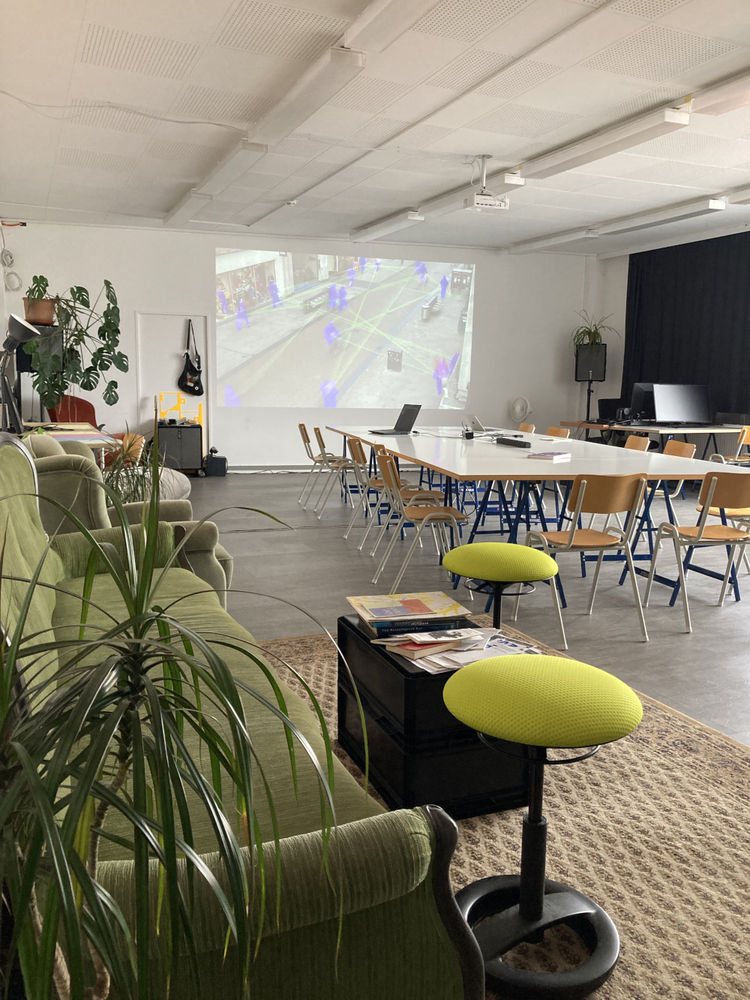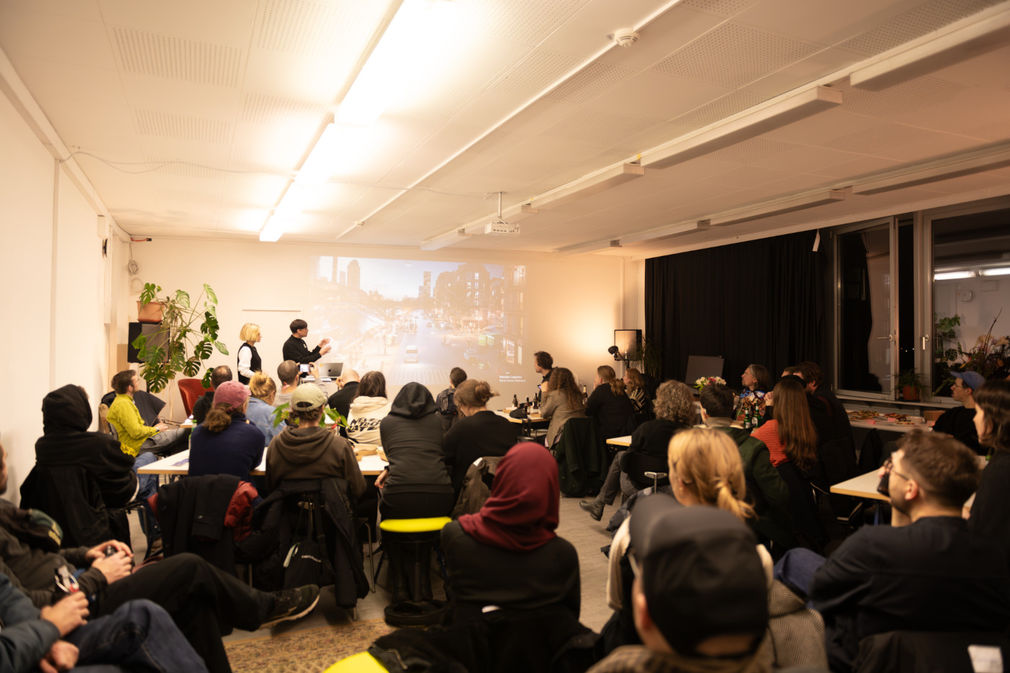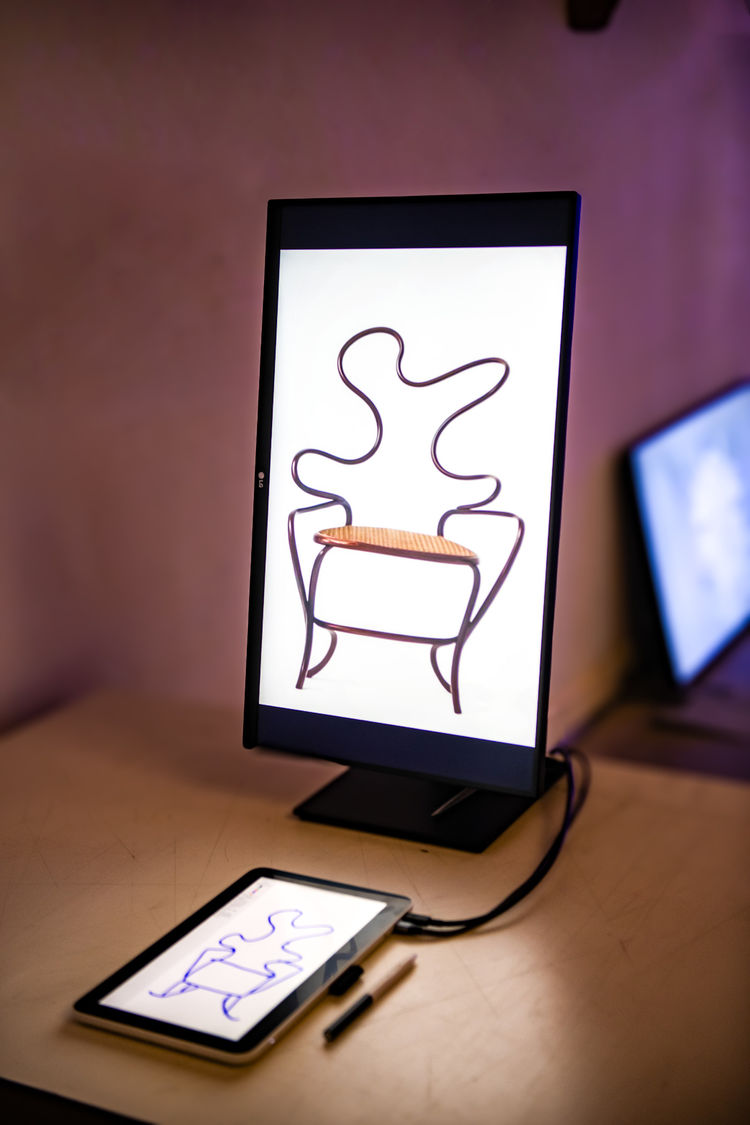AI Lab

The AI Lab is part of the Electronic Media department in the Faculty of Art. In the AI Lab, the examination of artificial intelligence systems is not only about the mere application of the technology for one's own practice, but also about a deeper understanding of the underlying processes and their reflection. Practical criticality enables artists and designers to not only use existing tools according to predefined methods, but also to modify them according to their own needs. This critical examination of AI is urgently needed in view of its rapid spread in society. Artistic / design research into AI systems is particularly well suited to this task due to its sensory experience and openness to the results. We therefore combine theory and practice, art and AI, technology and design.
Funded by the German Federal Ministry of Education and Research as part of the joint project "KITeGG KI greifbar machen und begreifen: Technologie und Gesellschaft verbinden durch Gestaltung (Making AI tangible and understandable: Connecting technology and society through design)". Further information https://gestaltung.ai/
-
Prof. Alexander Oppermann
T +49 (0)69.800 59-220
West wing, room D101
Leon Etienne Kühr
Research Associate
Lead AI Lab
Westflügel, Raum 307
Mattis Kuhn
Research Associate
Lead AI Lab
Westflügel, Raum 307
KI-Abend

Neben Kursen und einem offenen Lab veranstalten wir in unregelmäßigen Abständen KI-Abende, um bei Drinks und Snacks über Projekte aus Kunst und Gestaltung, aktuelle Entwicklungen und Paper zu sprechen. Der Abend ist offen für Alle, auch Interessierte, die nicht der Hochschule angehören. Er dient als Plattform, um KI-Themen zu besprechen. Die Inhalte der Abende können partizipativ mitgestaltet werden, beispielsweise können Paper, Tools oder Projekte vorgestellt und besprochen werden. Wenn ihr Vorschläge habt, meldet euch gerne bei uns: kuhn@hfg-offenbach.de, kuehr@hfg-offenbach.de
KI & Komprimierung
Ästhetik des Hyperdurchschnitts
Was haben Claude Shannon's Entropie-Gedanken gemeinsam mit der überwiegend banalen Kultur der Computer-Interaktion? In der Untersuchung der Ästhetik des Hyperdurchschnitts wird die Produktion der heutigen Template Culture durch die Linse von Komprimierung und Generativer KI beleuchtet. KI-Sprachmodelle sind Komprimierungsmaschinen, die systematisch Entropie reduzieren und dadurch eine "Template Culture" des Hyperdurchschnitts produzieren. Die Interaktion selbst wird in diesem Prozess zur Low-Entropy-Performance. Das System optimiert für "Engagement", wobei die Ästhetik der Interaktion zur Erscheinungsform der Verwertungslogik wird. Die Metriken belohnen das Erwartbare, das reibungslos Funktionierende. Die Ästhetik des Hyperdurschnitts ist eine ritualisierte Kultur von rekursiven Interaktionstemplates, in denen der nächste Output versucht, einen möglichst reibungslosen weiteren Input zu erzeugen. Was darauf folgt, ist ein systematischer Informationsverlust entlang aller Dimensionen, die für die Metrik irrelevant sind.
Kjell Wistoff und Conrad Weise behandeln in ihrem Vortrag diese Aspekte der Komprimierung von Interaktionen, wenn wir mit Systemen wie ChatGPT interagieren. Anhand des experimentellen Forschungsprojekts "I Apologize for the Confusion" werden sie demonstrieren, wie sich die Ästhetik des Hyperdurchschnitts in der Interaktion mit diesen Systemen manifestiert.
Die Veranstaltung wird unterstützt von hessian.AI — The Hessian Center for Artificial Intelligence.
29. Oktober 2025, 18 Uhr
Hauptgebäude, Raum 307
Do. 2. Mai 2024, 18 Uhr – Das Lab sagt Hallo!
Do. 23. Mai 2024, 18 Uhr – KI und Literatur
Do. 20. Juni 2024, 18 Uhr – KI und Krieg
Mi. 20. November 2024, 18 Uhr – KI und Robotik
Do. 12. Dezember 2024, 19 Uhr – KI und Zukünfte
Mi. 29. Januar 2025, 19 Uhr – KI und Sexismus
Mi. 12. Februar 2025, 18 Uhr – KI und Fotografie
Mi. 25. Juni 2025, 18 Uhr – KI und Vergangenheit
Mi. 29. Oktober 2025, 18 Uhr – KI und Komprimierung
Student work
j00n — ELIZA bot (2024)
“What I had not realised is that extremely short exposures to a relatively simple computer program could induce powerful delusional thinking in quite normal people.” – Joseph Weizenbaum – Computer Power and Human Reason (1976)
The interactive installation »bl00t - ELIZA bot« explores interactions with a talking chatbot. An adaptation of Joseph Weizenbaum's ELIZA chatbot from 1966 speaks with a real-time AI voice and responds to typed user input. The simple ELIZA algorithm enables latency-free interaction. The robot's voice amplifies the (ELIZA) effect.
Raspberry PI 5, Python, Piper (text-to-speech), light sensor
Elise Olenina — Draw Me a Circle (2024)
Im Schaffensprozess sind wir häufig stark von den Tools abhängig, die wir nutzen. Sie können den Prozess so beeinflussen, dass die ursprüngliche Idee verloren gehen kann. Um dieses Feld zu untersuchen, hat Elise Olenina eine Reihe von Befehlen formuliert, die typischen Aufgaben im Designprozess entsprechen, etwa das Erstellen eines Objekts, dessen Neuordnung, das Hinzufügen weiterer Elemente, das Positionieren in bestimmten Formen usw. Diese Eingabeaufforderungen wurden von einem Large Language Model verarbeitet, das aus Code und Text, jedoch nicht aus Bildern gelernt hat. Die Ausgaben erfolgen als SVG-Codes, welche als statische und animierte Vektorgrafiken gezeigt werden.
In Form von Prompts versucht Elise Olenina ihren kreativen Gestaltungsprozess nachzuahmen. Wie strukturieren wir Dinge? Wie schaffen wir Ordnung und wie gehen wir mit Chaos um? Welche Kriterien unterscheiden menschliche Arbeit von maschineller? Und kann die Sprache unsere Intentionen während des Gestaltungsprozesses sichtbar machen?
LLM, Paper, Display

Zhichang Wang — Stuhl (2024)
Photo: Cheesoo Park
Zhichang Wang — Stuhl (2024)
Computer, monitor, graphics tablet, Stable Diffusion (SDXL), Custom Model, ComfyUI, Python
The interactive installation Stuhl (chair) uses AI real-time generation to expand the design process of chairs based on the Thonet chairs. Visitors can draw or sketch freely on a graphics tablet. Whether spontaneous lines or simple sketches—the system stimulates the imagination and helps to design individual Thonet chairs. A ComfyUI workflow ensures that the generation process runs smoothly and quickly and that the AI system can process image requests efficiently. It is based on the basic SDXL model from Stability AI and uses a specially trained LoRA model and the LCM model for real-time image generation. Especially with drawings that are very close to the shapes of chairs, the AI system manages to design a chair that matches the style of the drawing by interpreting the lines.


















